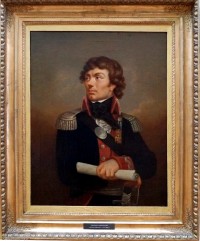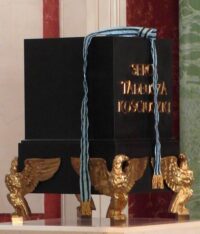A study of the vessel containing the heart of Thaddeus Kosciuszko, engineer, hero of the American Revolutionary War and leader of the 1794 Polish uprising against Russia that bears his name, has found evidence that he may have died when a common skin bacterium infected his heart.
The experts said last month they found the genome of the Cutibacterium acne in the wax, wood and linen that had long-term contact with the tissues of Kosciuszko’s heart, which has been preserved. They said it could have led to endocarditis, or inflammation inside the heart, and to his death, aged 71, in Switzerland.
 Born in the Polish–Lithuanian Commonwealth in 1746 to a noble family, Kosciuszko left for Paris in 1768 when civil war, family conflict and political infighting kept him from receiving a commission. In Paris he embraced Enlightenment humanism and learned architecture while expanding his military knowledge. He joined the American colonists’ fight against Britain in 1776, and received a commission from the Continental Congress as a colonel in the engineers.
Born in the Polish–Lithuanian Commonwealth in 1746 to a noble family, Kosciuszko left for Paris in 1768 when civil war, family conflict and political infighting kept him from receiving a commission. In Paris he embraced Enlightenment humanism and learned architecture while expanding his military knowledge. He joined the American colonists’ fight against Britain in 1776, and received a commission from the Continental Congress as a colonel in the engineers.
The United States benefited from his brilliance as a military architect for seven years. He returned to the Polish–Lithuanian Commonwealth in 1784, and finally received his longed-for commission as a major general in 1789. He wouldn’t even have to wait three years to get the opportunity to become a hero fighting for his own country. Kosciuszko’s success on the field, most famously in the Battle of Dubienka (1792) when he defeated 25,000 Russians with just 5,300 soldiers, made him a national hero. It wasn’t enough for King Stanisław August Poniatowski, however, who capitulated to Russia anyway and ordered the army to stand down. Kosciuszko resigned his commission and tried his own hand at revolt against Russia. The Kosciuszko Uprising was not successful and Thaddeus was captured. His stint as a Russian prisoner of war ended in 1796 with the death of Catherine the Great and the ascension of Tsar Paul I.
Kosciuszko lived something of a peripatetic existence after that, traveling in the United States and Europe, advocating with Napoleon, who he saw clearly as a dictator who had sounded the death knell of the French Revolution, for a democratic Polish state. He died in 1817 in Solothurn, Switzerland after having fallen from a horse into a cold stream and developed a fever.
 As with another Polish hero, Frederic Chopin, Kosciuszko’s heart was preserved separately from his other organs and body. His embalmed body was initially interred in the crypt of the Solothurn church before it was transferred to the Wawel Cathedral to keep company with kings and other national heroes. His heart was kept in an urn at the Polish Museum in Rapperswil, Switzerland, for 110 years until it was repatriated to Poland. It is now in Warsaw’s Royal Castle.
As with another Polish hero, Frederic Chopin, Kosciuszko’s heart was preserved separately from his other organs and body. His embalmed body was initially interred in the crypt of the Solothurn church before it was transferred to the Wawel Cathedral to keep company with kings and other national heroes. His heart was kept in an urn at the Polish Museum in Rapperswil, Switzerland, for 110 years until it was repatriated to Poland. It is now in Warsaw’s Royal Castle.
The team was led by Prof. Michał Witt, head of the human genetics institute at the Polish Academy of Sciences in Poznan and Dr. Tadeusz Dobosz of the Wroclaw Medical University. They took the samples for their molecular tests from a vessel where the heart is being kept, at the Royal Castle in Warsaw.
Under some conditions, skin bacteria can attack the internal organs, including the heart, leading to very serious problems, Witt told Polish Radio Zet24.
He stressed that it’s hard to say for sure what caused Kosciuszko’s death but that their findings have led them to the “rationally based hypothesis” that it was the acne bacteria that caused the documented rapid deterioration of his health and death.